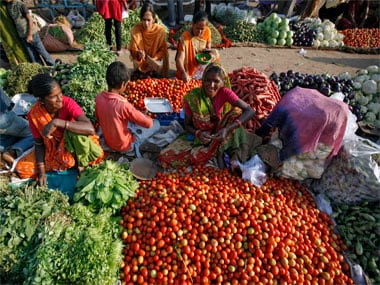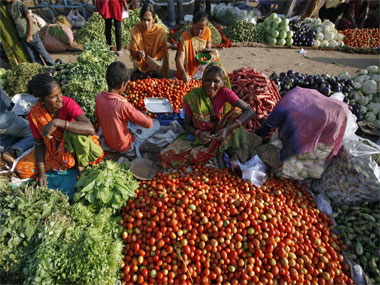Is food inflation likely to rear its ugly head again, challenging the inflation targeting exercise of the Reserve Bank of India yet again? The International Monetary Fund (IMF) believes it could and it is not basing itself on the latest numbers on consumer price inflation (CPI) that came out yesterday. In a Selected Issues Paper prepared for the annual consultations with India (something that is done for each member country), the IMF forewarns of the re-emergence of food demand pressures as economic growth picks up again. [caption id=“attachment_2152021” align=“alignleft” width=“380”]
 It is observed that three quarters after an El Nino event, inflation in India witnesses a 60 basis point jump[/caption] “An estimated sample average household food budget expenditure elasticity of 0.64 implies that if food supply growth rates stay near their 10-year historic averages, then relative food price pressures will likely reappear when annual private consumption growth exceeds five percent.” Without a stronger food supply growth response, the paper warns, relative food inflation can contribute 1.25 percentage points to headline inflation annually. The paper acknowledges the several steps the Narendra Modi government has taken to tame food inflation – putting a lid on procurement prices, the adjustment of buffer stock norms so that the government was not sitting on huge piles of food grain and the release of food grains from the central pool into the market. While this tamed inflation in cereals, it points out that demand pressures for the protein-rich foods (dairy, meat, poultry) as well as fruits and vegetables will remain strong. The paper estimates that the growth of demand for such products will remain about 1.5 to 1.7 times the demand growth for cereals and pulses. The paper shows that the growth in the supply of the high value foods has been higher than in the case of cereals. While supply of cereals grew 2.6 percent a year between 2005-06 and 2012-13, that of pulses, milk and milk products, eggs, fish and meat and vegetables and fruits grew between 4.6 percent and 5 percent. This supply growth will need to be sustained if food price pressures arising from economic growth are to be contained, the paper says. But there could be a threat to this in the short term. The paper points to a likely El Nino effect in the first quarter of 2015. (The paper was written before both the United States and Australia put out El Nino event warnings earlier this month). El Nino, a climatic condition marked by rising sea surface temperatures, affects rainfall and hence agriculture. In India, El Nino conditions, the paper says, usually coincide with a period of weak monsoon and rising temperatures in India. Agriculture gets hit and domestic food prices start rising. The paper notes that a 60 basis point jump in inflation has been observed in India, three quarters after an El Nino event. It does acknowledge that this has not always happened – there have been only six droughts in India since 1980, though there have been nine El Nino events. This is a point agriculture economist Ashok Gulati has also made in a July 2014 paper, El Nino and Indian Droughts – A Scoping Exercise, published by ICRIER. However, he notes that since 2000, out of four El Nino years globally, three resulted in Indian droughts. The IMF paper also notes that Indian agriculture has become less susceptible to El Nino over the years. The factors responsible for this are an increase in the contribution of rabi and decline in kharif crops, more developed agricultural markets and policies, rising agricultural yield, early warning systems on climate and the ability of farmers to switch to more drought-resistant and short-duration crops. But this should not lead to complacency, both the IMF paper and the Gulati paper point out. The IMF paper suggests changes in cropping patterns rainwater conservation, judicious release of food grain stocks, and changes in imports policies/quantities to mitigate the effects of El Nino. Gulati categorises the liquidation of food stalks and bringing down import tariffs as short term measures. In the long term, he argues, “the country needs to invest in agriculture, mainly in irrigation to stabilize production, and in building efficient value chains, especially for high value perishable commodities”. He also makes a strong case for moving government spending on agriculture away from subsidies to investment in infrastructure and reorienting MGNREGA towards recharging ground water. Weather experts are still debating on how severe this year’s El Nino will be. But given that the likelihood of demand pressures pushing up food inflation, it’s perhaps time that serious attention was given to agriculture and food production.
It is observed that three quarters after an El Nino event, inflation in India witnesses a 60 basis point jump[/caption] “An estimated sample average household food budget expenditure elasticity of 0.64 implies that if food supply growth rates stay near their 10-year historic averages, then relative food price pressures will likely reappear when annual private consumption growth exceeds five percent.” Without a stronger food supply growth response, the paper warns, relative food inflation can contribute 1.25 percentage points to headline inflation annually. The paper acknowledges the several steps the Narendra Modi government has taken to tame food inflation – putting a lid on procurement prices, the adjustment of buffer stock norms so that the government was not sitting on huge piles of food grain and the release of food grains from the central pool into the market. While this tamed inflation in cereals, it points out that demand pressures for the protein-rich foods (dairy, meat, poultry) as well as fruits and vegetables will remain strong. The paper estimates that the growth of demand for such products will remain about 1.5 to 1.7 times the demand growth for cereals and pulses. The paper shows that the growth in the supply of the high value foods has been higher than in the case of cereals. While supply of cereals grew 2.6 percent a year between 2005-06 and 2012-13, that of pulses, milk and milk products, eggs, fish and meat and vegetables and fruits grew between 4.6 percent and 5 percent. This supply growth will need to be sustained if food price pressures arising from economic growth are to be contained, the paper says. But there could be a threat to this in the short term. The paper points to a likely El Nino effect in the first quarter of 2015. (The paper was written before both the United States and Australia put out El Nino event warnings earlier this month). El Nino, a climatic condition marked by rising sea surface temperatures, affects rainfall and hence agriculture. In India, El Nino conditions, the paper says, usually coincide with a period of weak monsoon and rising temperatures in India. Agriculture gets hit and domestic food prices start rising. The paper notes that a 60 basis point jump in inflation has been observed in India, three quarters after an El Nino event. It does acknowledge that this has not always happened – there have been only six droughts in India since 1980, though there have been nine El Nino events. This is a point agriculture economist Ashok Gulati has also made in a July 2014 paper, El Nino and Indian Droughts – A Scoping Exercise, published by ICRIER. However, he notes that since 2000, out of four El Nino years globally, three resulted in Indian droughts. The IMF paper also notes that Indian agriculture has become less susceptible to El Nino over the years. The factors responsible for this are an increase in the contribution of rabi and decline in kharif crops, more developed agricultural markets and policies, rising agricultural yield, early warning systems on climate and the ability of farmers to switch to more drought-resistant and short-duration crops. But this should not lead to complacency, both the IMF paper and the Gulati paper point out. The IMF paper suggests changes in cropping patterns rainwater conservation, judicious release of food grain stocks, and changes in imports policies/quantities to mitigate the effects of El Nino. Gulati categorises the liquidation of food stalks and bringing down import tariffs as short term measures. In the long term, he argues, “the country needs to invest in agriculture, mainly in irrigation to stabilize production, and in building efficient value chains, especially for high value perishable commodities”. He also makes a strong case for moving government spending on agriculture away from subsidies to investment in infrastructure and reorienting MGNREGA towards recharging ground water. Weather experts are still debating on how severe this year’s El Nino will be. But given that the likelihood of demand pressures pushing up food inflation, it’s perhaps time that serious attention was given to agriculture and food production.
Attention RBI: Food inflation may return on El Nino scare and higher demand, warns IMF
Seetha
• March 13, 2015, 14:09:01 IST
The IMF paper also notes that Indian agriculture has become less susceptible to El Nino over the years
Advertisement
)
End of Article